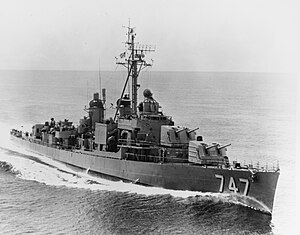USS Samuel N. Moore
 USS Samuel N. Moore underway in 1950s
| |
| History | |
|---|---|
| Name | Samuel N. Moore |
| Namesake | Samuel Nobre Moore |
| Builder | Bethlehem Mariners Harbor |
| Laid down | 30 September 1943 |
| Launched | 23 February 1944 |
| Sponsored by | Mrs. Samuel N. Moore |
| Commissioned | 24 June 1944 |
| Decommissioned | 24 October 1969 |
| Stricken | 24 October 1969 |
| Identification |
|
| Fate | Transferred to the Republic of China , 10 December 1969 |
| Badge |  |
| Name |
|
| Namesake | Heng Yang |
| Acquired | 10 December 1969 |
| Commissioned | 25 April 1970 |
| Identification | Hull number: DD-2 |
| Reclassified |
|
| Decommissioned | 1 December 1994 |
| Stricken | May 1995 |
| Fate | Sunk as target |
| General characteristics | |
| Class and type | Allen M. Sumner-class destroyer |
| Displacement | 2,200 tons |
| Length | 376 ft 6 in (114.76 m) |
| Beam | 40 ft (12 m) |
| Draft | 15 ft 8 in (4.78 m) |
| Propulsion |
|
| Speed | 34 knots (63 km/h; 39 mph) |
| Range | 6,500 nmi (12,000 km; 7,500 mi) at 15 kn (28 km/h; 17 mph) |
| Complement | 336 |
| Armament |
|
USS Samuel N. Moore (DD-747), an Allen M. Sumner-class destroyer, is the only ship of the United States Navy to be named for Samuel N. Moore.
Namesake

Samuel Nobre Moore was born on 7 September 1891 in Washington, D.C. He entered the United States Naval Academy in 1909 and was commissioned Ensign in 1913. From April 1914 to February 1915, he served on board USS Hopkins (DD-6) and participated in the occupation of Veracruz. He served on USS Nicholson (DD-52) from May 1915 to January 1917 and on USS Michigan (BB-27) while the United States participated in World War I.
During the interwar period, he held numerous naval posts ashore and at sea with the
Construction and commissioning
Samuel N. Moore (DD-747) was
World War II
Following shakedown off
After Japan capitulated, Samuel N. Moore aided occupation forces, visiting
Korean War
In response to
Departing Long Beach on 4 May 1954, she cruised with antisubmarine forces in the western Pacific; patrolled Taiwan Strait, and visited the
From 1955 through 1959, she made annual deployments to the western Pacific, visiting the Philippines, Taiwan, and Japan. In 1960 and 1961, she served with a specialized antisubmarine task force in the western Pacific, before conducting operations off the West Coast in 1962 and 1963.
Vietnam War
From 13 March to 2 October 1964, Samuel N. Moore was away from Long Beach on another deployment to the western Pacific. In August, during the crisis following the Gulf of Tonkin incident, Samuel N. Moore supplied ammunition to the destroyer Maddox, and transferred documents from Maddox and Turner Joy to Ticonderoga.
Sailing from the West Coast for the western Pacific on 28 September 1965, she provided gunfire support off Vietnam, operated as a plane guard in the South China Sea, and fired on targets in the Mekong Delta, before returning to Long Beach on 8 April. Getting underway again for the western Pacific on 28 March 1967, she patrolled off North Vietnam, as part of Operation Sea Dragon, and protected aircraft carriers in the Tonkin Gulf, before arriving at Long Beach on 20 September. Underway from Long Beach to the western Pacific on 18 July 1968, she again conducted several shore bombardments and guarded carriers in the Tonkin Gulf before returning to Long Beach on 26 February 1969.
In April, she became a Naval Reserve training ship at
She was sold in December 1969 to the
Notes
Citations
- This article incorporates text from the public domain Dictionary of American Naval Fighting Ships. The entry can be found here.
- ^ a b c "Samuel N. Moore (DD-747)". Dictionary of American Naval Fighting Ships. Navy Department, Naval History and Heritage Command. Retrieved 28 November 2015.
- ^ Blackman 1971, p. 68
- ^ Couhat & Baker 1986, p. 450
- ^ Gardiner & Chumbley 1995, p. 456
- ^ a b Prézelin & Baker 1990, pp. 511–512
- ^ Baker 1998, p. 850
References
- Baker, A.D., ed. (1998). The Naval Institute Guide to Combined Fleets of the World 1998–1999. Annapolis, Maryland, USA: Naval Institute Press. ISBN 1-55750-111-4.
- Blackman, Raymond V.B., ed. (1971). Jane's Fighting Ships 1971–72. London: Sampson Low, Marston & Co., Ltd. ISBN 0-354-00096-9.
- Couhat, Jean Laybayle; Baker, A.D., eds. (1986). The Naval Institute Guide to Combined Fleets of the World 1986/87. Annapolis, Maryland, USA: Naval Institute Press. ISBN 0-85368-860-5.
- Gardiner, Robert; Chumbley, Stephen, eds. (1995). Conway's All the World's Fighting Ships 1947–1995. Annapolis, Maryland, USA: Naval Institute Press. ISBN 1-55750-132-7.
- Prézelin, Bernard; Baker, A.D., eds. (1990). The Naval Institute Guide to Combined Fleets of the World 1990/1991. Annapolis, Maryland, USA: Naval Institute Press. ISBN 0-87021-250-8.
